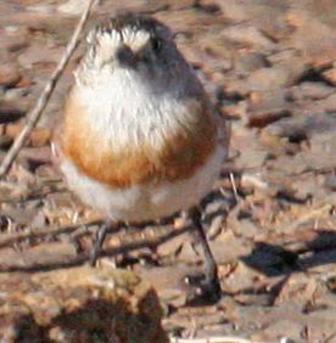Chestnut-breasted Whiteface
The species's preferred habitat is open terrain in hilly areas such as tablelands, with a stony landscape and a patchy cover of perennial chenopod shrubs. The species is most frequently seen in areas where the topographic relief gives rise to creek lines, in which there tends to be denser shrubby vegetation. It feeds on the ground and takes seeds and arthropods. It is threatened by habitat loss.

Original source: Chestnut-breasted_Whiteface_(Aphelocephala_pectoralis)_from_front.jpg: Tony Morris from St Margaret's at Cliffe, Kent UK
Author: Chestnut-breasted_Whiteface_(Aphelocephala_pectoralis)_from_front.jpg: Tony Morris from St Margaret's at Cliffe, Kent UK
The Chestnut-breasted Whiteface is classified as Near Threatened (NT), is close to qualifying for or is likely to qualify for a threatened category in the near future.
The Chestnut-breasted Whiteface (Aphelocephala pectoralis) is a species of bird in the Pardalotidae family. It is endemic to Australia and found primarily in northern South Australia. Habitat - The species's preferred habitat is open terrain in hilly areas such as tablelands, with a stony landscape and a patchy cover of perennial chenopod shrubs. More
Although the elusive Chestnut-breasted Whiteface was first described in 1871, ornithologists were unable to find its nest and eggs until 1968. Found only in the stony, sparsely shrubbed tablelands of northern South Australia, these birds build a globular nest with a side-entrance, loosely constructed from dead twigs, lined with wool and feathers. More
Click to listen to sound samples The Chestnut-breasted Whiteface is generally regarded as the only bird endemic to South Australia but there is at least one possible record just over the N.T. border (62 km east of Kulgera). It ranks high on the list of sought after species amongst twitchers, probably because the few known places where it can be seen are a long way from major centres, and mainly in open saltbush country - not everybody's idea of an ideal campsite. More
The Chestnut-breasted Whiteface is one of those birds that are simply tough to see. They are found in a handful of locations but most are totally inaccessible to birders and really there is only one relatively reliable, somewhat easily accessible location and that is at Lyndhurst Station, just up the Strzelecki Track. I ended up spending a full day searching for these birds and I was almost ready to give up. More
straight for the Chestnut-breasted Whiteface sites on Mt Lyndhurst. The sun was starting to set and i found myself in a vast, apparently barren, windswept environment with little signs of life. After giving up on finding the 'mine site', the 'two gates site' and 'car wreck site', I thought i'd just get out and see what was around. I knew i was in 'roughly' the right area, but the rocky hills provided little inspiration. I headed down into a small gully... More
The Chestnut-breasted Whiteface Aphelocephala pectoralis is South Australia's only true endemic. It is confined to north-central and north-east SA and can, for example, be found on the arid plains along the lower Strzelecki track east of Lyndhurst, or near Coober Pedy. They feed inconspicuously on the ground and have a soft trilling call. Unmistakable by its broad, rusty breastband, it hops on the ground in small flocks and mixes with other Whiteface species .....more. Chestnut-breasted Whiteface, October 2003, Lyndhurst (c) P Morris. More
Chestnut-breasted Whiteface, Cinnamon Quail-thrush, Thick-billed Grasswren, Short-tailed Grasswren, Red-lored Whistler, Gilbert's Whistler, Chirruping Wedgebill, Redthroat, Slender-billed Thornbill & Orange Chat in South Australia. More
I have not added Chestnut-breasted Whiteface to this site yet, if you want to know more, try these following link. More
Family : Acanthizidae
Genus : Aphelocephala
Species : pectoralis
Authority : (Gould, 1871)
